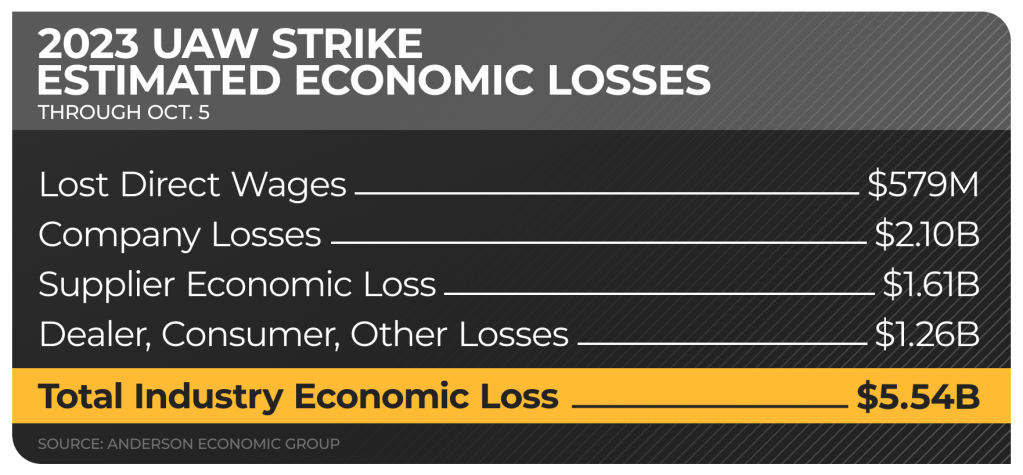
SIMONE DEL ROSARIO: THREE WEEKS. THAT’S HOW LONG UNITED AUTO WORKERS HAVE HELD THE LINE AGAINST FORD, GM AND STELLANTIS. NOW, THERE ARE WHISPERS OF PROGRESS AT THE BARGAINING TABLE AS BOTH SIDES LOSE HUNDREDS OF MILLIONS EACH WEEK THE STRIKE GOES ON.
UAW WORKER ROY WOOD: It’s kind of hard now. We’re just in our first week for me and we’re just waiting for this to come to a conclusion, hopefully fast.
SIMONE DEL ROSARIO: STRIKING WORKERS ARE LIVING OFF $500 A WEEK FROM THE STRIKE FUND, WHILE FIGHTING FOR HIGHER PAY IN THE PLANTS.
SHAY MANAWAR: You cannot ignore the fact that there is an economic loss being incurred every day while the strike is still going.
SIMONE DEL ROSARIO: SHAY MANAWAR AND ANDERSON ECONOMIC GROUP HAVE BEEN TRACKING THOSE LOSSES SINCE DAY ONE, WHEN ROUGHLY 13,000 UAW WORKERS WALKED OUT OF THREE PLANTS IN MICHIGAN, OHIO AND MISSOURI. IN WEEK TWO, THE STRIKE EXPANDED BY 5,600 MORE WHO WALKED OUT OF 38 DISTRIBUTION PLANTS.
SHAY MANAWAR: First two weeks, we’re looking at $3.95 billion in economic losses. Third or fourth week might look different.
SIMONE DEL ROSARIO: $3.95 BILLION INCLUDES $325 MILLION IN LOST WAGES AND $1.1 BILLION IN COMPANY LOSSES. SUPPLIERS AND DEALERS NOT DIRECTLY INVOLVED IN THE STRIKE ARE LOSING EVEN MORE. THE FIGURES DON’T INCLUDE WEEK THREE, WHEN NEARLY 7,000 MORE WORKERS WALKED OUT OF FORD’S CHICAGO PLANT AND GM’S LANSING PLANT.
SHAY MANAWAR: We do anticipate additional impact, not just on the manufacturers as well as suppliers, but also in consumers. Distribution centers are being either impacted or closed, workers are being laid off. That means the dealerships that not just rely on selling new cars, but also have different departments such as used and body shops. If they’re not able to get their job done that is also impacting consumers directly.
SIMONE DEL ROSARIO: WHEN UAW LAST WENT ON STRIKE IN 2019 AGAINST GM, THE SIX-WEEK STALEMATE PUSHED MICHIGAN INTO A SINGLE-QUARTER RECESSION.
SHAY MANAWAR: This time around, we are looking at not just Michigan but also other states.
SIMONE DEL ROSARIO: WHILE GM IS ALSO BRACING FOR ADDITIONAL STRIKES. THE COMPANY SAID THIS WEEK IT TOOK OUT A $6 BILLION DOLLAR LINE OF CREDIT IN CASE UAW LEADERSHIP QUOTE “INTEND TO DRAG THIS ON FOR MONTHS.” FORD IS PRESENTING A MORE OPTIMISTIC FRONT, ANNOUNCING ITS “SEVENTH AND STRONGEST OFFER” TO UAW, WHICH INCLUDES IMMEDIATE PAY RAISES TOPPING 20% AND INFLATION PROTECTION DOWN THE ROAD. FOR STRAIGHT ARROW NEWS, I’M SIMONE DEL ROSARIO.










